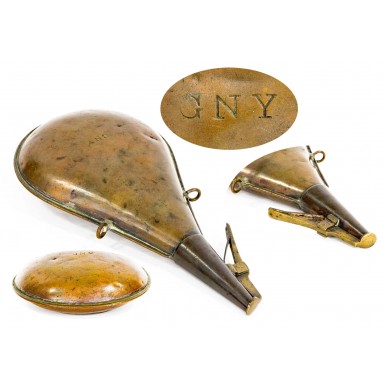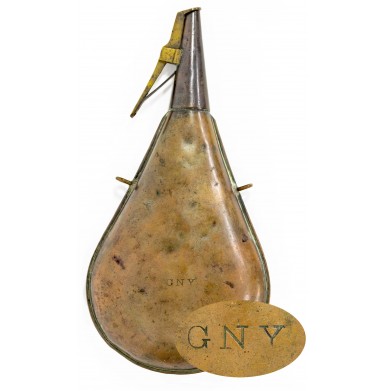Gosport Navy Yard "GNY" Marked Powder Flask - Rare - Only 500 Produced
- Product Code: FPTA-TB522-SOLD
- Availability: Out Of Stock
-
$1.00
From the inception of the American Navy, the cow’s horn had been the container of choice for priming powder for cannons. Invariably these horns were simply a larger version of powder horn carried by nearly every owner of a muzzleloading firearm. Initially they were plugged in the same way, with a wood insert in the spout, but towards the end of the 18th century the use of the British thumb lever operated closure mechanism became more common. By the early 19th century in America the mechanically operated spout stopper was standard and with the exception of some refinements to the wood base plug, the introduction of a threaded stopper in the butt to ease the refilling of the horn and some improvements in the slinging system, little changed for the American Naval Priming Horn from the end of the Revolutionary War to the early 1840s. However, by early 1842 the Navy was seriously considering replacing the venerable cow’s horn for priming powder with a copper flask. To that end on 24 February 1842 a letter was sent from Captain Lewis Warrington USN to Captain B. Kennon at the Washington Navy Yard. It read in part:
“The Commissioners have it in contemplation to introduce a substitute for the power horn which will be more convenient, and economical than the horn, now used in the service, and they desire you to have six copper flasks made and sent to the this office, of the shape shown in the enclosed diagram with a thumb spring, at the top, large enough to hold one pound of priming powder with a statement of their costs.”
A week later a second letter was sent from Warrington to Kennon that read in part:
“If you are making, or intend to make powder horns, the board desires you to stop all further work on them, as they wish to substitute a copper flask, in place of the horn. You will therefore consider the flask, which is made all of copper, as the pattern, allowing it to be a little flatter, and the eyes to be somewhat rounded, to prevent chaffing. Let 500 of them be made. The object of the Board, is to have a more convenient, economical and safer article, than the horn hitherto used, and they believe that the proposed flasks will be found to combine the whole of the qualifications.”
With these two letters, the origin and accurate identification of the long enigmatic NYW marked (Navy Yard Washington) and GNY (Gosport Navy Yard) powder flasks is firmly established. An examination of the two flasks, which are pictured in Ray Riling’s’ classic The Powder Flask Book as Figures 867 and 868, shows that the Washington Navy Yard flask is similar in size and profile to the well-known Naval Flasks that would follow it from Ames, Adams and Stimpson and the Gosport flask is of the type described in the second letter, as “a little flatter”. The letter clearly indicates that 500 of these flatter flasks were to be produced to replace the priming horns then in use. The Washington Navy Yard marked example was almost certainly used as the pattern for the production of the small arms powder flasks that the Navy would start contracting for in 1843, initially from Ames and subsequently from Stimpson and then Adams.
Over the years this information, all of which is readily available in Riling’s book, was apparently generally lost and many dealers and auction houses have offered the rare Gosport Navy Yard priming flasks, as small arms flasks. From a design standpoint this is obviously incorrect, as the thumb lever spout closure of the GNY flask is at the end of the spout. For the spout of a small arms flask to deliver a measured charge, the closure must be at the base of the spout. To use a small arms flask, the charging spout is covered by the thumb, the closure in the base of the spout is opened and the flask is inverted, allowing powder to fill the spout. The stopper is then released, trapping a measured charge of powder between the closure and the mouth of the spout. When the closure it as the mouth of the spout, opening it simply allows the free pouring of powder. This works fine to prime cannons but does not allow a measured charge to be dispensed for small arms. Thus, the very form of the stopper clearly indicates the flask is a priming flask and not a small arms flask.
The newly adopted “flat” copper flask was marked with the stamped letters G N Y for Gosport Navy Yard on both sides of the body. The letters measured nominally 13/16” in height. The flask measured nominally 11” in overall length with a body that was roughly 8” wide and slightly less than 6” thick. Two fixed suspension rings were attached to the flask body along the edge seam, slightly less than half-way down the body of the flask. The charging spout was tapered at the end, measuring 3” in length on the shorter side and about 1/8” longer on the other. The thumb actuated spring-loaded charging stopper was of brass and was little changed from the one that had been in use on American naval priming horns for more than six decades. The flasks were intended for use priming the cannons of various US naval ships, sloops, frigates, and the like. The manufacture of only 500 of the flasks and their use on board ship no doubt explains why surviving examples are so scarce. The priming flasks remained in use with the US Navy until the widespread adoption of the percussion cannon lock. Interestingly the percussion cannon locks, primarily of Enoch Hidden’s design, were starting to be obtained in reasonable quantities at about the same time the decision was taken to replace the priming horn with the copper priming flask. On 1 March 1843, a major order for some 1,500 percussion naval cannon locks indicates that the age of the priming horn, and the new priming flask was rapidly coming to an end. For this reason, it seems unlikely that any additional priming flasks were produced at the Gosport Navy Yard, after the initial 500 were manufactured.
The rare GNY marked Gosport Navy Yard priming flask offered here remains in about FINE condition overall. The flask is 100% complete, correct and remains fully functional. The flask has an untouched rich bronze patina. The flask body shows numerous scattered bumps, dings and minor dents scattered over all of the exterior surfaces with a larger minor crease below the “GNY” mark on one side, that is about 3”-4” in length. The seams of the flask all remain tightly sealed and the suspension loops remain in place as well. The stopper functions smoothly and operates as it should. The stamped G N Y markings on both sides of the flask remain crisp, clear, and fully legible.
Overall, this is a very attractive, untouched example of a scare US naval flask that shows real world use but no abuse. The flask represents the change from horns to metal flasks for powder storage and is from the period of change over from the use of flint locks to fire naval cannons to the introduction of percussion locks for the same purpose. The survival rate for these flasks is fairly low and with only 500 produced, they are quite rare on the collector market. This would be a fine addition to any mid-19th century US Naval collection and would fit in as well in general naval collection as it would with one that focuses on naval cannon. Some collectors also consider these flasks as secondary Confederate items, as the Confederacy captured the Gosport Naval Yard in April of 1861 and would retain the US Naval Yard in Norfolk for about a year. Despite a concerted effort by the Federal forces that were abandoning the yard to scuttle ships and destroys those stores that could not be carried off, the Confederacy managed to salvage a large number of cannons, a significant of small arms and equipment, naval stores, ships and most notably the USS Merrimack, which would be raised and rechristened as the iron clad ram CSS Virginia. The Virginia nee Merrimack would be engaged in the famous Clash of the Iron Clads at Hampton Roads with the USS Monitor on March 8 and 9, 1862. On 1 May 1862 Federal forces would recapture the Gosport Navy Yard in Norfolk after slightly more than a year in southern hands. After the recapture of the facility, the use of the name Gosport Navy Yard gradually fell out of use, with the naval base becoming more generally referred to as the Norfolk Navy Yard.
Provenance: ex-Trevor Bovee Collection
SOLD
Tags: Gosport, Navy, Yard, GNY, Marked, Powder, Flask, Rare, Only, 500, Produced










